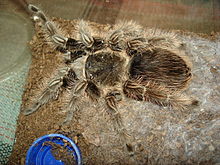- Brachypelma albopilosum
-
"Curlyhair" redirects here. For the texture of hair, see Curly hair.
Brachypelma albopilosum 
Honduran curlyhair tarantula Scientific classification Kingdom: Animalia Phylum: Arthropoda Class: Arachnida Order: Araneae Family: Theraphosidae Genus: Brachypelma Species: B. albopilosum Binomial name Brachypelma albopilosum
Valerio, 1980Brachypelma albopilosum is a species of tarantula known commonly as the Honduran curlyhair or simply Curlyhair tarantula. Its native range includes Central America, from Honduras to Costa Rica . They are terrestrial, opportunistic burrowing spiders. This tarantula is covered in long hairs that have a characteristic curl to them giving them a unique look.
Contents
Description
The Curlyhair tarantula is a plump-bodied spider, covered with dark brown to black hair. It has a golden-bronze sheen due to longer gold hairs that cover the whole body, which are particularly dense on the hind legs.[1] Males are often a lighter bronze color than females.[2]
Range and Habitat
The range of the Curlyhair tarantula stretches along the Atlantic side of Honduras, Nicaragua and north-eastern Costa Rica. A burrowing species, the curlyhair tarantula is found in tropical rain forest regions, either around the base of large trees, near rivers, or in patches of cleared rain forest.[2][3]
Biology
Receptive females will allow a male to mate, usually during the rainy season, resulting in the making of an egg sac and the laying of 300 to 500 eggs several weeks later.[3] The egg sac is incubated for about seven to eight weeks at 24 to 27 degrees Celsius, after which pale-colored young emerge and cluster together. The spiderlings develop quickly, molting again over the next couple of weeks, by which time they disperse to live independent lives. Unreceptive females are likely to be aggressive towards approaching males and may try to kill and eat them.[2][3]
Primarily a nocturnal, opportunistic ambusher, the curlyhair tarantula preys on insects and small vertebrates. An area on the end of each leg is sensitive to smell, taste and vibration, and is used to detect prey. The tarantula holds its prey with its pedipalps (front limbs) and injects it with venom delivered via two hollow fangs. This venom has a double purpose, paralysing the prey, as well as beginning digestion.Once the venom has acted the tarantula is able to suck up the proteins and fats of its prey, leaving just a small ball of undigested body parts.[2][3] This usually docile tarantula will kick hairs off the abdomen with its hind legs when threatened, which cause blindness if they hit the eyes of a predator and can also cause a rash on the skin.[3]
Conservation
The largest threat to the Curlyhair tarantula is now habitat loss. Once captured in large numbers for the international pet trade, the curlyhair tarantula is now bred in captivity worldwide and relatively few are caught in the wild.[2] Listed on Appendix II of the Convention on International Trade in Endangered Species (CITES), the curlyhair tarantula can now only be traded internationally according to quotas and with trade permits.[4]
As pets
B. albopilosum is frequently kept and bred in captivity. They feed readily on commercially available crickets and cockroaches. They are typically docile. Females are long-lived, potentially reaching 15 years of age.
References
This article incorporates text from the ARKive fact-file "Brachypelma albopilosum" under the Creative Commons Attribution-ShareAlike 3.0 Unported License and the GFDL.
- ^ "Eight: A site about tarantulas". April, 2005. http://www.eightlegs.org/. Retrieved July 21, 2011.
- ^ a b c d e Baxter, R.N. (1993). Keeping and Breeding Tarantulas. Ilford, Essex: Chudleigh Publishing.
- ^ a b c d e West, R. (2008) Pers. comm.
- ^ "CITES". CITES. April, 2008. http://www.cites.org. Retrieved July 21, 2011.
External links
Brachypelma albopilosum media at ARKive
Categories:- Theraphosidae
- Fauna of Honduras
- Fauna of Costa Rica
- Fauna of Central America
- Spiders of North America
Wikimedia Foundation. 2010.

